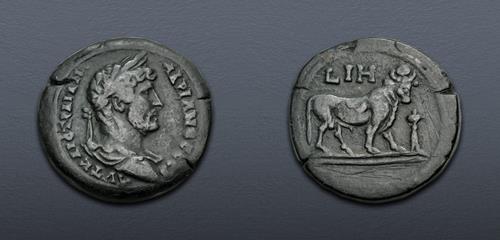
|
EGYPT, Alexandria. Hadrian. AD 117-138. Æ Diobol (25mm, 10.18 g, 12h). Dated RY 18 (AD 133/4). VF.
Electronic Auction 583
Lot: 469. Estimated: $ 100
The Beniak Collection of Alexandrian Coinage, Bronze
Sold For $ 425. This amount does not include the buyer’s fee.
Go to Live
|
|
EGYPT, Alexandria. Hadrian. AD 117-138. Æ Diobol (25mm, 10.18 g, 12h). Dated RY 18 (AD 133/4). Laureate, draped, and cuirassed bust right, seen from behind / Apis bull standing right, crescent on flank, wearing solar disk and menat necklace; to right, altar; L IH (date) above. Köln 1102; Dattari (Savio) 2009 & 7919; K&G 32.610; RPC III 5927; Emmett 1114.18. Brown patina, cleaning marks. VF.
From the Dr. Thomas E. Beniak Collection, purchased from Nilus Coins, 28 April 2005.
In Egyptian mythology, Apis is a sacred bull worshipped primarily in Memphis. Identified as the son of Hathor, a primary deity in the pantheon of ancient Egypt, he was initially assigned a significant role in her worship, being sacrificed and reborn. Later, Apis also served as an intermediary between humans and other powerful deities (first Ptah, later Osiris, then Atum).
The Apis bull was one of the most important of all the sacred animals in Egypt, and, as with the others, this importance increased as time went on. During the colonization of Egypt, Greek and Roman authors had much to say about the Apis bull: the markings by which the black calf was recognized, the manner of his conception by a ray from heaven, his house at Memphis with a court for his amusement, the mode of prognostication from his actions, his death, the mourning at his death, his costly burial, and the rejoicings throughout the country when a new Apis was found. Auguste Mariette's excavation of the Serapeum of Saqqara revealed the tombs of more than sixty animals, ranging from the time of Amenhotep III to that of the Ptolemaic dynasty.
Closing Date and Time: 19 March 2025 at 12:36:00 ET.
All winning bids are subject to a 20% buyer’s fee.
|
